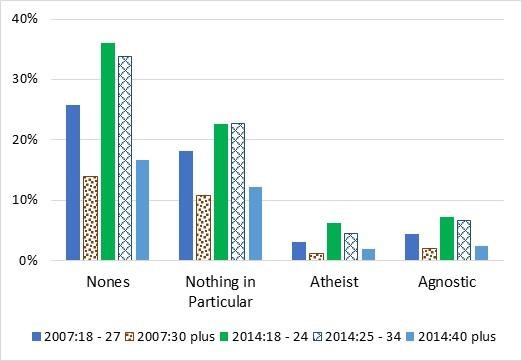By: Steve Cable – probe.org – December 17, 2017
Pew Research has done a great service to those who want to understand the current trends of religious beliefs in America. In 2007, they interviewed about 35,000 Americans to create the 2007 American Religious Landscape Study {1}. Then in 2014, they interviewed a similar size group of Americans using many of the same questions (along with a few new or different questions) to create the 2014 American Religious Landscape Study{2}. Most surveys of this nature include 1,000 to 3,000 respondents which limits their accuracy when considering subsets of the data by age, religious preference, education, ethnicity, etc. By collecting responses from such a large number of people, we can look at these subsets with a much greater level of confidence.
I want to begin by updating our understanding of the dominant religious trend in America this century: the so-called rise of the Nones{3}. The Nones are those people who choose not to affiliate with any religious tradition. In the Pew survey, Nones include atheists, agnostics, and “nothing in particular” respondents. We can understand how this phenomenon is growing by examining the results shown in Figure 1. People were asked “What is your present religion, if any?”
In Figure 1, the first group of bars reflects the percentage of Nones at different times (i.e. 2007 and 2014) and for different age segments. The first two bars show the percentage of Nones in 2007 for those between 18 and 27, and for those 30 years and older. As shown, over 25% of Americans under the age of 28 selected a None category. For those 30 and older, only 14% selected a None category. This was a tremendous growth over the levels up to the early 1990’s when the GSS survey{4} reported 11% of those under 30 and 7% of those 30 and over.
But this amazing growth in Nones is far from over, as shown in the last three bars in the first group summarizing the response in 2014. As shown, the youngest group (ages 18 – 24) showed 36% selecting a None category. The group from 25 to 34 selected None at almost the same rate, 34%. This age group would have been 18 to 27 in 2007 when about 25% of them selected None. Over this seven-year period almost 10% of that age group switched from some other religion to None. Even those over forty increased to 17%, a significant growth over the level only seven years earlier for those age 30 plus at the time.
The next three sets of bars break the Nones up into the three constituencies: Nothing in Particular, Atheist and Agnostic. About two thirds of Nones identify as Nothing in Particular with the remainder about evenly split between Atheist and Agnostic.
In my next post, we will see what these Nones believe about basic Christian doctrine and if they have a somewhat active spiritual life. And in later post, we will also look to see what religions these Nones identified with as children.
For now, our bottom line takeaway is that more than 46% of emerging adults (ages 18 through 29) identify with either another religion (10%) or None (36%), meaning that in a few short years the majority of American emerging adults will identify as something other than a Christian.
To see this article, click read more.
Source: Update on Nones: Continuing to Dominate the Developing American Religious Scene
 Listen Online
Listen Online Watch Online
Watch Online Find a Station in Your Area
Find a Station in Your Area







 Listen Now
Listen Now Watch Online
Watch Online
